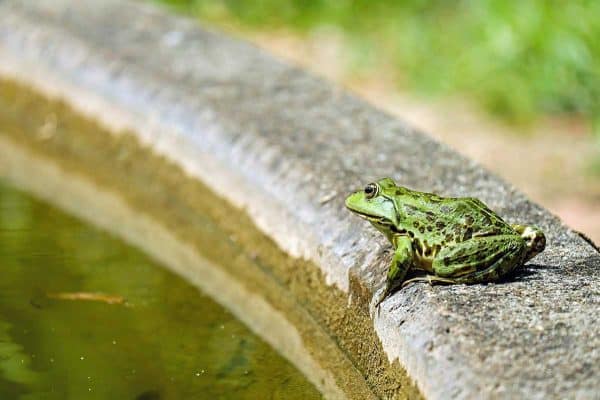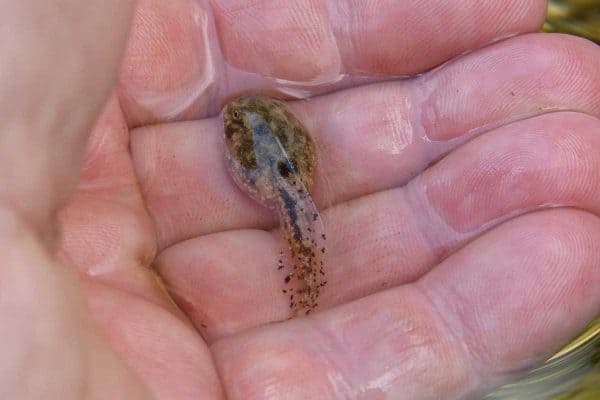Frogs are well known for having strong back legs that make them powerful jumpers and swimmers. Some frogs are even great at climbing trees. When looking at a small, smooth-skinned frog, it’s easy to wonder what their insides look like. Do frogs have backbones? Are they vertebrates or invertebrates? Find out answers to these questions and more about frogs and their anatomy.
Key takeaways
- Frogs have backbones to help support them, protect nerves, and aid in movement
- Tadpoles don’t have backbones but their cartilages will transform into bone
- Frogs are vertebrates with lightweight skeletons to help them jump and swim
Do frogs have backbones?
Yes, frogs have backbones. However, they don’t start their life with a backbone but gradually develop the feature through metamorphosis. Frogs hatch into larvae that become fully aquatic tadpoles. Tadpoles don’t have backbones and consist of mostly soft tissue and cartilage.
It isn’t until the tadpole becomes a froglet that the cartilage turns into bone, and the frog begins to develop a backbone. Other transformations that occur include the development of tongue muscles, a skull, and lungs so the froglet can live on land. Once the tail fully disappears, the froglet becomes an adult frog.

What is the frog’s backbone made of?
Frog backbones are made of calcium and specialized bone cells similar to human bones. Tadpoles will eat and absorb calcium phosphate and calcium carbonate to transform their cartilage into bones and become froglets. Frog bones also have bone marrow, which is where blood cells are made.
How many bones are in a frog’s back?
Most frogs have 10 vertebrae, which are a series of small bones that form the backbone. The frog’s first vertebra is the bone connecting the base of the frog’s skull and is called the atlas. It allows the frog to move its head. The next seven vertebrae are in the frog’s belly area.
The frog’s backbone includes a series of nerves running from the brain that is crucial to the frog’s survival. Their backbones help protect these nerves from potential damage. Unlike humans, frogs don’t have ribs connected to their backbones. However, they do have a spinal cord.

What does a frog use its backbone for?
Generally, frogs use their backbone for support and movement. Their backbone is connected to their wide hipbones and helps them jump, swim, or climb trees easier.
They have a fused backbone which allows them to propel forwards or upward when jumping without causing pain to their backs due to recoil.
While all types of frogs have bone structures, their bones’ weight, size, and physical qualities will differ depending on their daily habits. Besides support and movement, frog bones also help protect their vital organs.
Skeletal functions for a frog
The frog’s skeleton protects their vital organs, provides support for their bodies, and are attachment surfaces for their muscles. Their skeletons are also very lightweight and exclude unnecessary structures so they can be more agile and flexible when jumping.
The frog’s leg and foot bones are lanky with fragile bones. However, their back legs are very powerful and heavily muscled. Frogs also have extra joints in their back legs that allow them to fold up close to their bodies when they are resting.
Do tadpoles have backbones?
No, tadpoles don’t have backbones. As previously mentioned, the tadpole has flexible cartilage that will eventually transform into bones as they develop into froglets and adult frogs.

Tadpoles are soft and fragile with simplified skeletal systems and long tails. The main structure of their body is the notochord which is a long rod of cartilage that supports their bodies and helps them swim.
Are frogs vertebrate or invertebrate?
Since frogs do have backbones, they are clearly vertebrates since invertebrates do not have bones. All amphibians are cold-blooded vertebrates with a spinal column. Examples of amphibians are toads, frogs, salamanders, and newts. In contrast, animals without backbones are called invertebrates. Examples of invertebrates are insects, worms, and spiders.
Conclusion
Yes, frogs have backbones and are considered vertebrates. Their bones are made from calcium similar to humans but are very lightweight and allow them to propel forward without hurting their backs from the recoil.
However, frogs don’t start off with backbones since tadpoles consist mostly of cartilages and soft tissues. The transformation into froglets with backbones is a fascinating component of the frog life cycle.


